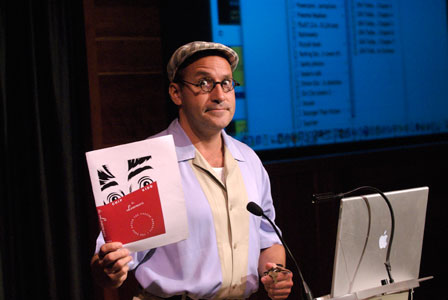
Chip Kidd Biography and Photos
Chip Kidd (born September 12, 1964) is an American author, editor, and graphic designer, best known for his innovative book covers

Born in Reading, Pennsylvania, Kidd grew up in the Reading suburb of Shillington, strongly influenced by American popular culture. While a design student at Penn State, an art instructor once gave the assignment to design a book cover for Museums and Women by John Updike, who is also a Shillington native. The teacher panned Kidd's work in front of the class, suggesting that book design would not be a good career choice for him.[citation needed] (Ironically,, Kidd later received professional assignments to design covers for Memories of the Ford Administration and other books by Updike.)
Kidd is currently associate art director at Knopf, an imprint of Random House. He first joined the Knopf design team in 1986, when he was hired as a junior assistant by Sara Eisenman. Publishers Weekly described his book jackets as "creepy, striking, sly, smart, unpredictable covers that make readers appreciate books as objects of art as well as literature."USA Today also called him "the closest thing to a rock star" in graphic design today, while author James Ellroy has called him “the world’s greatest book-jacket designer.”
Turning out jacket designs at an average of 75 a year, Kidd has freelanced for Doubleday, Farrar Straus & Giroux, Grove Press, HarperCollins, Penguin/Putnam, Scribner and Columbia University Press in addition to his work for Knopf. Kidd also supervises graphic novels at Pantheon, and in 2003 he collaborated with Art Spiegelman on a biography of cartoonist Jack Cole, Jack Cole and Plastic Man: Forms Stretched to Their Limits. His output includes cover concepts for books by Mark Beyer, Bret Easton Ellis, Haruki Murakami, Dean Koontz, Cormac McCarthy, Frank Miller, Michael Ondaatje, Alex Ross, Charles Schulz, Osamu Tezuka, David Sedaris, Donna Tartt, John Updike and others. His design for Michael Crichton's Jurassic Park novel was carried over into marketing for the film adaptation. Oliver Sacks and other authors have contract clauses stating that Kidd design their books.
His novel The Cheese Monkeys (Simon and Schuster, 2001) is an academic satire and coming-of-age tale about state college art students who struggle to meet the demands of sadistic art instructors. The book draws on Kidd's real-life experiences during his art studies at Penn State. Its sequel The Learners, was released in 2008.
Kidd is currently associate art director at Knopf, an imprint of Random House. He first joined the Knopf design team in 1986, when he was hired as a junior assistant by Sara Eisenman. Publishers Weekly described his book jackets as "creepy, striking, sly, smart, unpredictable covers that make readers appreciate books as objects of art as well as literature."USA Today also called him "the closest thing to a rock star" in graphic design today, while author James Ellroy has called him “the world’s greatest book-jacket designer.”
Turning out jacket designs at an average of 75 a year, Kidd has freelanced for Doubleday, Farrar Straus & Giroux, Grove Press, HarperCollins, Penguin/Putnam, Scribner and Columbia University Press in addition to his work for Knopf. Kidd also supervises graphic novels at Pantheon, and in 2003 he collaborated with Art Spiegelman on a biography of cartoonist Jack Cole, Jack Cole and Plastic Man: Forms Stretched to Their Limits. His output includes cover concepts for books by Mark Beyer, Bret Easton Ellis, Haruki Murakami, Dean Koontz, Cormac McCarthy, Frank Miller, Michael Ondaatje, Alex Ross, Charles Schulz, Osamu Tezuka, David Sedaris, Donna Tartt, John Updike and others. His design for Michael Crichton's Jurassic Park novel was carried over into marketing for the film adaptation. Oliver Sacks and other authors have contract clauses stating that Kidd design their books.
His novel The Cheese Monkeys (Simon and Schuster, 2001) is an academic satire and coming-of-age tale about state college art students who struggle to meet the demands of sadistic art instructors. The book draws on Kidd's real-life experiences during his art studies at Penn State. Its sequel The Learners, was released in 2008.

Kidd is widely known as a fan of comic book media, particularly Batman, and has written and designed book covers for several DC Comics publications, including The Complete History of Batman, Superman, and Wonder Woman, The Golden Age of DC Comics: 365 Days, and the aforementioned Jack Cole and Plastic Man. He also designed Mythology: The DC Comics Art of Alex Ross and wrote an exclusive Batman/Superman story illustrated by Ross for the book. Kidd once stated that the first cover he ever noticed was "no doubt for some sort of Batman comic I saw when I was about 3, enough said. Or maybe not enough said: the colors, the forms, the design. Batman himself is such a brilliant design solution." Veronique Vienne, who wrote an eponymous book about Kidd in 2006, described Kidd's Batman fandom as a "childhood obsession and lasting adult passion."
The author is also a serious collector of Batman merchandise which fills his Manhattan apartment. In 2001, Kidd designed and wrote Batman: Collected which features his childhood photos and several pieces from his vintage Batman collection as photographed by Geoff Spear. In the 287-page book, he writes extensively of his nostalgic memories and of Batman as a merchandising icon. Kidd also worked with fellow Batman collector Saul Ferris on another book of a more particular subject matter, Bat-Manga!: The Secret History of Batman in Japan, which hit stores shelves in October 2008
The author is also a serious collector of Batman merchandise which fills his Manhattan apartment. In 2001, Kidd designed and wrote Batman: Collected which features his childhood photos and several pieces from his vintage Batman collection as photographed by Geoff Spear. In the 287-page book, he writes extensively of his nostalgic memories and of Batman as a merchandising icon. Kidd also worked with fellow Batman collector Saul Ferris on another book of a more particular subject matter, Bat-Manga!: The Secret History of Batman in Japan, which hit stores shelves in October 2008

In early 2008, Kidd started a new wave/alternative rock band, writing and recording music under the name Artbreak. He takes the role of song writing, vocals, and percussion, and while the group began as hobby, Kidd has expressed interesting in making a serious project out of it. As of 2008[update], the group performs across the United States and has a tour schedule on their MySpace. They plan to record their original songs for an album entitled Wonderground.

Kidd lives in a 1928 building on Manhattan's Upper East Side, separate from his partner, poet J.D. McClatchy who resides in Stonington, Connecticut. A biographical survey, Chip Kidd by Veronique Vienne (Yale University Press, 2003), was followed by Chip Kidd: Book One, Work: 1986–2006 (Rizzoli, 2005), curated and designed by Mark Melnick with text by Kidd.
Kidd's artistic influences are clearly "worn on his sleeve." His signature glasses are a replica of those worn by the Bauhaus designer Walter Gropius. Kidd's apartment includes cabinets showcasing his favorite book covers, signed by their authors, and display cases housing Batman memorabilia. It also has outlandish furniture such as chromed helicopter ejector seat, and along the walls are pieces by graphic designers Piet Zwart and Eileen Gray as well as comic book artists Alex Ross and Frank Miller.
Despite the wide praise of his work, Kidd has often downplayed the importance of cover designs, stating, "I'm very much against the idea that the cover will sell the book. Marketing departments of publishing houses tend to latch onto this concept and they can't let go. But it's about whether the book itself really connects with the public, and the cover is only a small part of that." He is also known to be humorously self-deprecating in regards to his work with statements such as "I piggy-backed my career on the backs of authors, not the other way around. The latest example of that is The Road, by Cormac McCarthy. I'm lucky to be attached to that. Cormac McCarthy is not lucky to have me doing his cover."
Kidd's artistic influences are clearly "worn on his sleeve." His signature glasses are a replica of those worn by the Bauhaus designer Walter Gropius. Kidd's apartment includes cabinets showcasing his favorite book covers, signed by their authors, and display cases housing Batman memorabilia. It also has outlandish furniture such as chromed helicopter ejector seat, and along the walls are pieces by graphic designers Piet Zwart and Eileen Gray as well as comic book artists Alex Ross and Frank Miller.
Despite the wide praise of his work, Kidd has often downplayed the importance of cover designs, stating, "I'm very much against the idea that the cover will sell the book. Marketing departments of publishing houses tend to latch onto this concept and they can't let go. But it's about whether the book itself really connects with the public, and the cover is only a small part of that." He is also known to be humorously self-deprecating in regards to his work with statements such as "I piggy-backed my career on the backs of authors, not the other way around. The latest example of that is The Road, by Cormac McCarthy. I'm lucky to be attached to that. Cormac McCarthy is not lucky to have me doing his cover."






No comments:
Post a Comment
Dear Visitor,
Please feel free to give your comment. Which picture is the best?
Thanks for your comment.